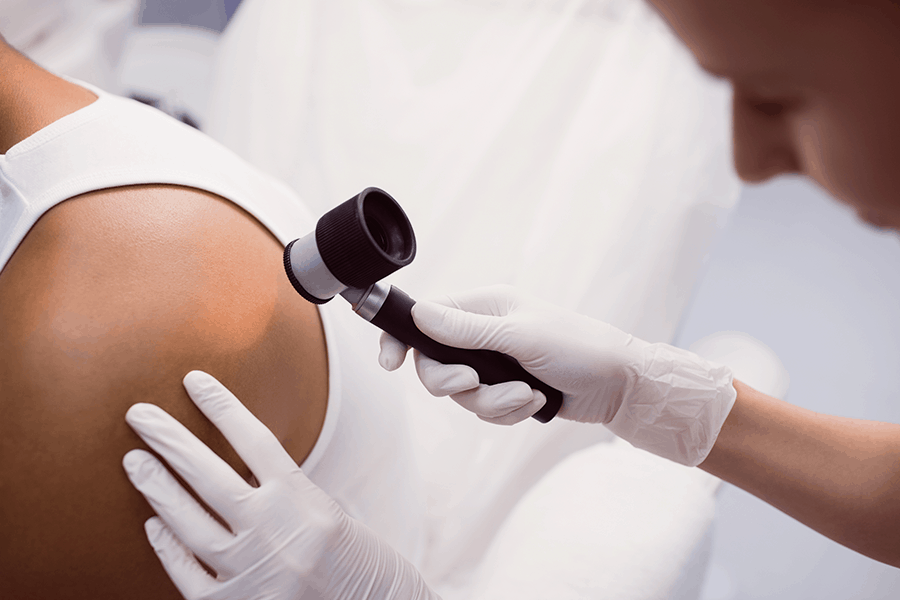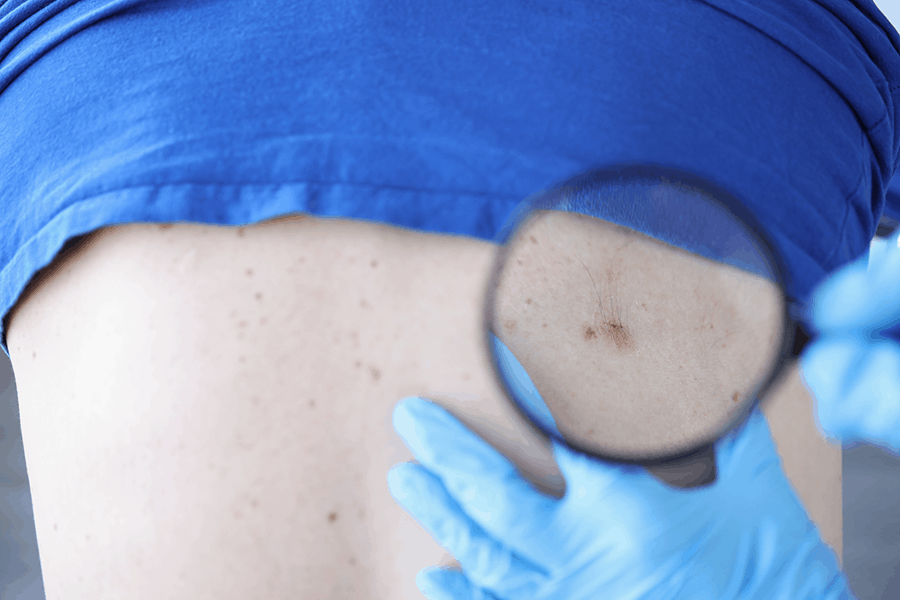Soft Tissue Masses
 Benign soft tissue masses
Benign soft tissue masses- Soft tissue sarcomas
- Diagnosing soft tissue masses
- Treating soft tissue sarcomas
- Living with soft tissue masses
Soft tissue masses are a type of tumor that can grow just about anywhere in the body, from the cartilage, ligaments, and muscles to the blood vessels, fat, and nerves. These masses can be cancerous (called a sarcoma) or benign and most commonly start in the arms, legs, abdomen, or chest. Some of these masses hover between cancerous and benign (called intermediate soft tissue tumors). Luckily, they can be removed relatively easily using minimally invasive techniques at Orlando Minimally Invasive Surgery.
Benign soft tissue masses occur about 10 times more commonly than malignant or cancerous masses. However, if you have a lump or a bump that is growing under your skin, seek medical attention to have it carefully checked out.
Benign Soft Tissue Masses
Benign soft tissue masses can vary widely in appearance, from a small round bump to an elongated mass. Some soft tissue masses that are benign can still aggressively spread and invade nearby tissue, which makes them harder to remove.
Soft tissue masses on the extremities of the body can masquerade as an old injury, such as a sprain or a hematoma (a bruise), but are typically easier to spot because there is less room than in your chest or abdomen. Benign soft tissue masses can be either painful to touch or completely painless, but typically grow more slowly than a sarcoma.
Some of the most common types of benign soft tissue masses include:
- Angiolipoma is a rare type of lipoma made up of blood vessels and fat
- Benign fibrous histiocytoma is a common type of fatty tumor
- Fibrous histiocytomas inhabit the fibrous tissue
- Glomus tumors occur near blood vessels
- Hemangiomas are formed by a mass of blood cells
- Lipomas, or benign tumors made up of fatty tissue
- Neurofibroma is a type of nerve tumor
- Schwannomas stem from cells that form a protective membrane around your nerve fibers
While this isn’t an exhaustive list of benign soft tissue tumors, most are made from lipomas, or fat, and occur just beneath the skin, growing slowly over time. Typically, they are a soft, painless bulge and present only a small risk to the patient.
Many times, your doctor will just carefully monitor the growth of the benign soft tissue mass. If needed, they can be surgically removed.
Soft Tissue Sarcomas
 Soft tissue sarcomas are rare and they begin in tissues that surround, connect, and support other bodily structures. These tissues can be hard to diagnose because they resemble other types of benign growths. Like benign soft tissue masses, soft tissue sarcomas are most common on the arms and legs or on the abdomen.
Soft tissue sarcomas are rare and they begin in tissues that surround, connect, and support other bodily structures. These tissues can be hard to diagnose because they resemble other types of benign growths. Like benign soft tissue masses, soft tissue sarcomas are most common on the arms and legs or on the abdomen.
There are more than 50 types of soft tissue sarcomas. Here are a few:
- Adult fibrosarcoma typically affects fibrous tissue and can occur in people of any age
- Angiosarcoma starts in the blood vessels or lymph vessels
- Desmoplastic small round cell tumor occurs in teens and young adults
- Fibromyxoid sarcoma, low-grade is a slow developing cancer that starts with a painless bump
- Gastrointestinal stromal tumor starts in the digestive tract
- Liposarcomas are cancerous tumors of fat tissue
- Myxofibrosarcomas, low-grade are often found in the arms and legs of elderly patients
- Rhabdomyosarcoma is the most common type of soft tissue sarcoma in children
Early detection of any type of soft tissue mass is critical to your health. While many times these masses are completely benign, it’s best to see your doctor immediately.
Diagnosing Soft Tissue Masses
Patients that have a lump can expect their doctor to take a complete history and perform a physical exam. Your doctor will likely ask you a number of questions, including:
- When did you first notice the lump?
- Has the lump grown in size?
- Are you in pain?
- Are there times when your symptoms worsen?
- Is there a family history of cancer?
The goal of your doctor is to accurately identify the tumor and prescribe treatment that will give you the best outcome.
A number of diagnostic tests may be ordered to help determine the type of tumor you’re experiencing. Your doctor may order one or several imaging tests such as:
- Angiogram
- Bone scan
- Computed tomography (CT) scan
- Magnetic resonance imaging (MRI)
- Positron emission tomography (PET) scan
- X-ray
These tests are painless and typically non-invasive. Once the imaging test reveals more about the soft tissue mass, your doctor will likely biopsy the mass to determine whether it is benign or malignant. A biopsy also causes minimal discomfort.
If the mass is benign, the surgeon may be able to remove it immediately; however, the mass may not even need removal. Benign soft tissue lipomas (or fat tumors), can often be watched instead of being removed. Your doctor may order an MRI every six to twelve months. Patients can live for years without these tumors disrupting their lives.
However, if the soft tissue mass is a sarcoma, your doctor will work closely with you to develop an individualized treatment plan.
Treating Soft Tissue Sarcomas
 The treatment approach for your soft tissue sarcoma will depend on the location of the tumor and its size. Minimally invasive surgery is a viable option in some cases, which involves removing the cancer and usually some of the cancer surrounding it.
The treatment approach for your soft tissue sarcoma will depend on the location of the tumor and its size. Minimally invasive surgery is a viable option in some cases, which involves removing the cancer and usually some of the cancer surrounding it.
The goal of surgery is to remove the cancer and up to an inch of normal tissue around it. Testing is done after the surgery to determine if cancer cells are found around the excised tissue. If cancer cells were left behind, more treatment, such as radiation, chemotherapy, or another surgery, may be needed.
At Orlando Minimally Invasive Surgery, our team will select the surgery that is right for you depending on the size and location of your tumor. We use special tools that make smaller incisions so your scarring and healing time will typically be less compared to traditional surgical procedures.
Our goal is to use the best techniques, individualized for your situation, to give you the highest quality of life after the procedure.
Living with Soft Tissue Masses
Soft tissue masses occur commonly at all stages in life. Benign soft tissue tumors can vary in size and some hurt, others do not. Unfortunately, just by looking at it, you will be unable to determine if that lump or bump is harmless or something to be concerned about. Fortunately, you have experts standing by at Orlando Minimally Invasive Surgery to help you treat your soft tissue mass. We know the appearance of a lump or bump is concerning, but our team is expert, caring, and standing by to help. Contact us today for an appointment.
Testimonials


Drag vertical bar, horizontally, to show before and after photos.


Sign Up for Our Newsletter to Get the Latest Updates
Sign Up for Our Newsletter to Get the Latest Updates
Oviedo/Winter Springs
(Inside Medical Office Building)
8400 Red Bug Lake Road
Suite 2090
Oviedo, FL 32765
Sanford Office
2100 West 1st Street
Sanford, FL 32771
Hospital Privileges at AdventHealth, HCA Lake Monroe Hospital, Orlando Health, Oviedo Medical Center, and UCF Lake Nona Hospital

